RBSE Solutions for Class 11 Physics Chapter 4 Motion in a Plane
Rajasthan Board RBSE Solutions for Class 11 Physics Chapter 4 Motion in a Plane Textbook Exercise Questions and Answers.
Rajasthan Board RBSE Solutions for Class 11 Physics in Hindi Medium & English Medium are part of RBSE Solutions for Class 11. Students can also read RBSE Class 11 Physics Important Questions for exam preparation. Students can also go through RBSE Class 11 Physics Notes to understand and remember the concepts easily.
RBSE Class 11 Physics Solutions Chapter 4 Motion in a Plane
RBSE Class 11 Physics Motion in a Plane Textbook Questions and Answers
Question 4.1.
State, for each of the following physical quantities, if it is a scalar or vector:
volume, mass, speed, acceleration, density, number of moles, velocity, angular frequency, displacement and angular velocity.
Answer:
Scalar quantities: Volume, mass, speed, density, number of moles, angular frequency.
Vector quantities: Acceleration, velocity, displacement, angular velocity.

Question 4.2.
Pick out the two scalar quantities in the following list:
Force, angular momentum, work, current, linear momentum, electric field, average velocity, magnetic moment, relative velocity.
Answer:
Work, current.
Question 4.3.
Pick out the only vector quantity in the following list:
Temperature, pressure, impulse, time, power, total path length, energy, gravitational potential, coefficient of friction, charge.
Answer:
Impulse.
Question 4.4.
State with reasons, whether the following algebraic operations with scalar and vector physical quantities are meaningful:
(a) adding any two scalars, (b) adding a scalar to a vector of the same dimensions, (c) multiplying any vector by any scalar, (d) multiplying any two scalars, (e) adding any two vectors, (f) adding a component of a vector to the same vector.
Answer:
(a) No; because the addtion of two scalars may be meaningful only when both scalars represent same physical quantity.
(b) No; because vector can be added with vector only and scalar can be added with scalar only.
(c) Meaningful; for example when acceleration vector (\(\vec{a}\)) is multiplied by scalar mass (m) then force is obtained which is vector (\(\vec{F}\) = m \(\vec{a}\)).
(d) Meaningful; for example, scalar quantity power (P) is multiplied by scalar quantity time (t), then we get work (W) which is scalar quantity.
(e) No; it will be meaningful only when both vectors represent the same physical quantity.
(f) Meaningful; because the component of a vector is also vector quantity. For example, component of force, also represents force.
Question 4.5.
Read each statement given below carefully and state with reason if it is true or false:
(a) The magnitude of a vector is always a scalar.
(b) Each component of a vector is always a scalar.
(c) The total path length is always equal to the magnitude of the displacement vector of a particle.
(d) The average speed of a particle (defined as total path length divided by the time taken to cover the path) is either greater or equal to the magnitude of average velocity of the particle over the same interval of time.
(e) Three vectors not lying in a plane can never add up to give a null vector.
Answer:
(a) True; for a particle moving in straight line, magnitude of velocity is equal to its speed.
(b) False; because each component of a vector is vector quantity and not a scalar quantity.
(c) False; total path length can be more than the magnitude of displacement of a particle.
(d) True; average speed depends upon the path length which can be more than the displacement vector of the particle and average velocity depends on displacement vector. Therefore average speed can be greater than the magnitude of average velocity and equal also.
(e) True; to obtain zero vector, third vector should be in opposite direction of resultant of two vectors which is possible only when, all the three vectors
are in same plane.

Question 4.6.
Establish the following vector inequalities geometrically or otherwise:
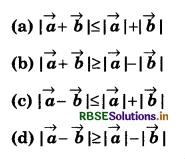
When does the equality sign above apply?
Answer:
Suppose vectors \(\vec{a}\) and \(\vec{b}\) are represented by \(\vec{OP}\) and \(\vec{OQ}\) respectively and resultant (\(\vec{a}\) + \(\vec{b}\)) of these vectors is represented by vector \(\vec{OR}\). Figure (i)
(a) To prove: | \(\vec{a}\) + \(\vec{b}\)| ≤ | \(\vec{a}\)| + | \(\vec{b}\)|
Since, in any triangle the sum of two arms is greater than third arm, therefore OR < (OQ + QR) or OR < (OQ + OP) or OR < (OP + OQ)
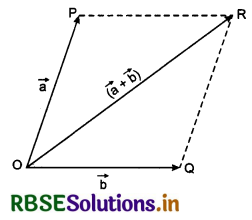
But OR = | \(\vec{a}\) + \(\vec{b}\) |; OP =| \(\vec{a}\) | and OQ = |\(\vec{b}\)|
∴ | \(\vec{a}\) + \(\vec{b}\)| < (| \(\vec{a}\)| + | \(\vec{b}\)|) ......................(1)
If \(\vec{a}\) and \(\vec{b}\) are lying in same straight line, then |\( \vec{a}\) + \(\vec{b}\)| = | \(\vec{a}\)| + | \(\vec{b}\)| ...........................(2)
On combining equations (1) and (2), we have,

(b) To prove: | \(\vec{a}\) + \(\vec{b}\)| ≥ (| \(\vec{a}\)| + | \(\vec{b}\)|)
From ∆ OQR, it is clear that,
(OR + OQ) > QR
or OR > (QR - OQ)
or | \(\vec{a}\) + \(\vec{b}\)| > (| \(\vec{a}\)| + | \(\vec{b}\)|) ..........................(3)
If \(\vec{a}\) and \(\vec{b}\) are lying on same straight line but in opposite direction, then
| \(\vec{a}\) + \(\vec{b}\)| = | \(\vec{a}\)| - | \(\vec{b}\)| ..........................(4)
On combining equations (3) and (4),

(c) To prove:
| \(\vec{a}\) - \(\vec{b}\)| ≤ [| \(\vec{a}\)| + | \(\vec{b}\)|]
In figure (ii),
\(\vec{OP}\) = \(\vec{b}\) and \(\vec{OM}\) = -\(\vec{b}\)

\(\vec{OL}\) = \(\vec{a}\)
\(\vec{ON}\) = (\(\vec{a}\) - \(\vec{b}\))
In triangle OMN,
ON < (MN + OM)
or ON < (OL + OM)
or | \(\vec{a}\) - \(\vec{b}\)| < [| \(\vec{a}\)| + | \(\vec{b}\)|] ......................(5)
When \(\vec{a}\) and \(\vec{b}\) are lying on same straight line but in opposite direction, then
| \(\vec{a}\) - \(\vec{b}\)| = | \(\vec{a}\)| + | \(\vec{b}\)| ......................(6)
On combining equations (5) and (6),

(d) To prove: | \(\vec{a}\) - \(\vec{b}\)| ≥ [| \(\vec{a}\)| - | \(\vec{b}\)|]
In ∆ OMN, (ON + OM) > MN
or ON > (MN - OM)
∵ MN = OL
∴ ON > (OL - OM)
or | \(\vec{a} - \vec{b}\)| > [| \(\vec{a}\)| - | \(\vec{b}\)|] ......................(7)
If \(\vec{a}\) and \(\vec{b}\) lie on same straight line and in same direction, then
| \(\vec{a} - \vec{b}\)| = [| \(\vec{a}\)| - | \(\vec{b}\)|] ......................(8)
On combining equations (7) and (8),

Question 4.7.
Given \(\vec{a}\) + \(\vec{b}\) + \(\vec{c}\) + \(\vec{d}\) = OL Which of the following statements are correct?
(a) \(\vec{a}\), \(\vec{b}\), \(\vec{c}\) and \(\vec{d}\) must each be a null vector.
(b) The magnitude of (\(\vec{a}\) + \(\vec{c}\)) equals the magnitude of (\(\vec{b}\) + \(\vec{d}\))
(c) The magnitude of \(\vec{a}\) can never be greater than the sum of the magnitude of \(\vec{b}\), \(\vec{c}\) and \(\vec{d}\).
(d) \(\vec{b}\) + \(\vec{c}\) must lie in the plane of \(\vec{a}\) and \(\vec{d}\) if \(\vec{a}\) and \(\vec{d}\) are not collinear and in the line of \(\vec{a}\) and \(\vec{d}\) if they are collinear.
Answer:
(a) False; because, the value of \(\vec{a} + \vec{b} + \vec{c} + \vec{d}\) may be zero when all vectors are null vectors and it may be zero by some other means also.
(b) True; because \(\vec{a} + \vec{b} + \vec{c} + \vec{d}\) = 0, therefore \(\vec{a} + \vec{c}\) = -(\(\vec{b} + \vec{d}\)). Hence magnitude of (\(\vec{a} + \vec{c}\)) is equal to that of (\vec{b} + \vec{d}) but directions of both vectors are opposite.
(c) True; because \(\vec{a} + \vec{b} + \vec{c} + \vec{d}\) = 0, therefore \(\vec{a}\) = -(\(\vec{b} + \vec{c} + \vec{b}\)). Hence magnitude of (\(\vec{b}+ \vec{c} + \vec{d}\)) may be equal to magnitude of a and it may be greater also.
(d) True; because \(\vec{a} + \vec{b} + \vec{c} +\vec{d}\) = 0 or (\(\vec{b} + \vec{c}\)) + \(\vec{a} + \vec{d}\) = 0 i.e. resultant of (\(\vec{b} + \vec{c}\)), \(\vec{a}\) and \(\vec{d}\) will be zero when \(\vec{a}\) and \(\vec{d}\) are collinear, then(\(\vec{b} + \vec{c}\)) should also be collinear with \(\vec{a}\) and \(\vec{d}\).
Question 4.8.
Three girls skating on a circular ice ground of radius 200 m start from a point P on the edge of the ground and reach a point Q diametrically opposite to P following different paths as shown in figure. What is the magnitude of the displacement vector for each? For which girl is this equal to the actual length of path skate?
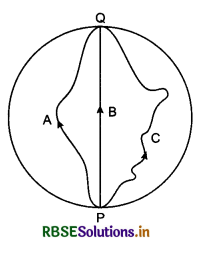
Answer:
Given: Radius of the ground R = 200 m
∴ Diameter of the ground D = 2R = 2 x 200 = 400 m. Since the displacement does not depend on the path actually adopted, it is the minimum distance between initial and final position of the path. Therefore the displacement of all the three girls will be same and equal to 400 m because the initial and final position are same for them. Since, the path adopted by girl B is diameter PQ. Therefore displacement of this girl will be equal to path length which is minimum.

Question 4.9.
A cyclist starts from the centre O of a circular park of radius 1 km, reaches the edge P of the park. Then cycles along the circumference and returns to the centre along QO as shown in figure. If the round trip takes 10 min, what is the (a) net displacement, (b) average velocity, (c) average speed of the cyclist?
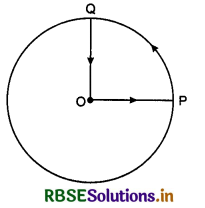
Answer:
(a) Zero, because initial and final positions are same.
(b) Average velocity
\(\overrightarrow{v_{a v}}=\frac{\text { displacement }}{\text { time }}=\frac{0}{\text { time }}\) = 0 (zero)
(c) Average speed
v = \(\frac{\text { total path length }}{\text { total time }}=\frac{O P+P Q+Q O}{10 / 60 \mathrm{hr}}\)
Given radius R = 1 km
∴ OP = OQ = 1 km
PQ = \(\frac{1}{2}\)πR = \(\frac{1}{2}\) x 3.14 x 1 km = 1.57 km
∴ Net path length = 1 km + 1.57 km + 1 km = 3.57 km
∴ Average speed v = \(\frac{3.57}{10 / 60}=\frac{3.57 \times 60}{10}\) km.h-1
= 21.42
= 21.4 kmh-1
Question 4.10.
On an open ground, a motorist follows a track that turns to his left by an angle of 60° after every 500 m. Starting from a given turn, specify the displacement of the motorist at the third, sixth and eighth turn. Compare the magnitude of the displacement with the total path length covered by the motorist in each case.
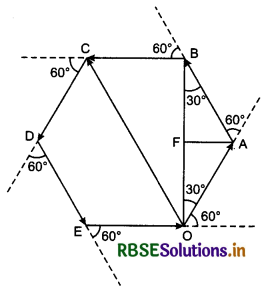
Answer:
(i) The path adopted by motorist is a closed curve, the shape of which is hexagonal as shown in figure. Motorist starts his journey from O. He takes third turn on C.
Displacement at third turn,
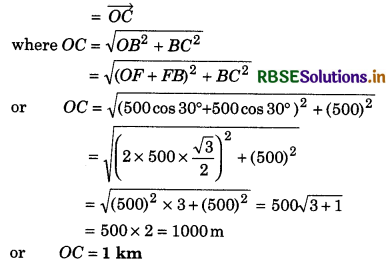
Total path length = 500 + 500 + 500 = 1500 m
= 1.5 km
∴ \(\frac{\text { Displacement }}{\text { Total path length }}=\frac{1 \mathrm{~km}}{1.5 \mathrm{~km}}=\frac{2}{3}\) = 0.67
(ii) Sixth turn of motorist will be at O i.e, its starting point.
∴ Displacement = 0 (zero) and total path length = 6 x 500 = 3000 m = 3 km
∴ \(\frac{\text { Displacement }}{\text { Total path length }}=\frac{0}{3 \mathrm{~km}}\) = 0 (zero)
(iii) Eight turn of motorist will be at B.
At this turn displacement = OB = OF + FB
= OB cos30° + AB cos30°
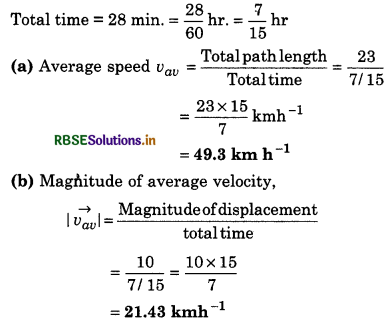
Total path length = 8 x 500 = 4000 m = 4 km
∴ \(\frac{\text { Displacement }}{\text { Total path length }}=\frac{\sqrt{3} / 2}{4}=\frac{\sqrt{3}}{8}\) = 0.22
Question 4.11.
A passenger arriving in a new town wishes to go from the station to a hotel located 10 km away on a straight road from the station. A dishonest cabman takes him along a circuitous path 23 km long and reaches the hotel in 28 min. What is (a) the average speed of the taxi?, (b) magnitude of average velocity? Are the two equal?
Answer:
Magnitude of displacement = 10 km
Total path length = 23 km
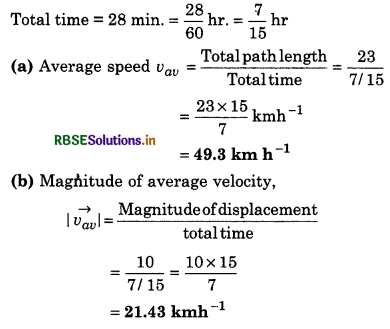
If is clear that vav and |\(\overrightarrow{v_{a v}}\)| are not equal.
Question 4.12.
Rain is falling vertically with a speed of 30 ms-1. A woman rides a bicycle with a speed of 10 ms-1 in the north to south direction. What is the direction in which she should hold her umbrella?
Answer:
Given:
vr = 30 ms-1
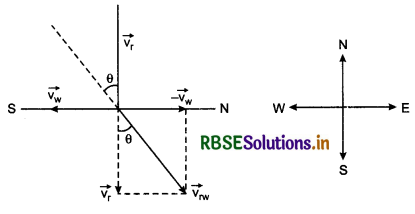
vw = 10 ms-1
Situations of velocities \(\overrightarrow{v_r}, \overrightarrow{v_\omega}\) and relative velocity of rain with respect to woman are shown in figure. For safety form rain the woman should hold her umbrella in opposite direction of relative velocity of rain with respect to woman. If the angle of umbrella with vertical is θ, then
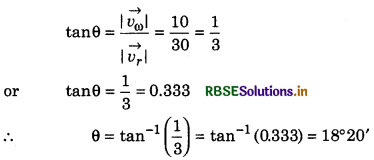
∴ The direction of umbrella should be 18°20' with vertical in south direction.
Question 4.13.
A man can swim with a speed of 4.0 kmh-1 in still water. How long does he take to cross a river 1.0 km wide if the river flows steadily at 3.0 km h-1 and he makes his stroke normal to the river current? How far down the river does he go when he reaches the other bank?
Answer:
Given: vm = 4.0 kmh-1
vr = 3.0 kmh-1
d = 1 km
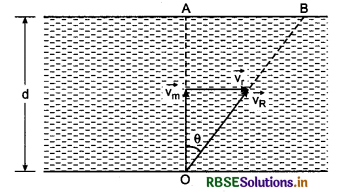
The time taken by swimmer to reach the opposite hank of river,
t = \(\frac{d}{v_m}=\frac{1}{4}\) = 0.25 h
∴ Distance AB = vr x t = 3.0 x 0.25
= 0.75 km
Question 4.14.
In a harbour, wind is blowing at the speed of 72 kmh-1 and the flag on the mast of boat anchored in the harbour flutters along the N-E direction. If the boat starts moving at a speed of 51 kmh-1 to the north, what is the direction of the flag on the mast of the boat?
Answer:
Relative velocity of wind with respect to boat
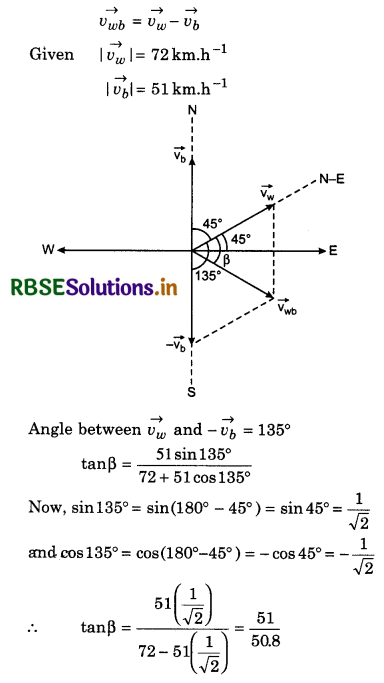
= 1.0039
∴ ß = tan-1(1.0039) = 45.1°
Therefore, the angle with east diection = 0.1°
Hence, the flag will flutter nearly in east direction.

Question 4.15.
The ceiling of a long hall is 25 m high. What is the maximum horizontal distance that a ball thrown with a speed of 40 ms-1, can go without hitting the ceiling of the hall?
Answer:
Given: u = 40 m/sec, H = 25 metre
Let the angle of projection is θ
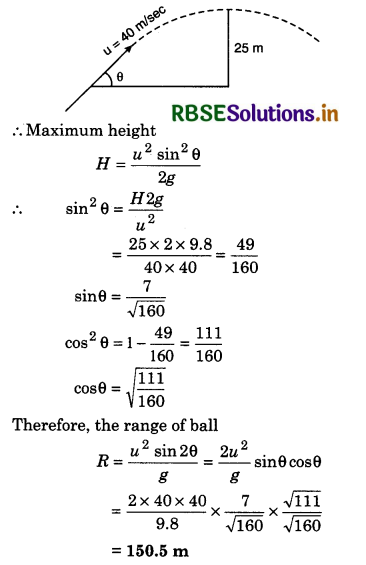
Question 4.16.
A cricketer can throw a ball to maximum horizontal distance of 100 m. How much high above the ground can the cricketer throw the same ball?
Answer:
Given: Rmax = 100 m, H = ?
∵ Rmax = \(\frac{v^2}{g}\)
⇒ u2 = Rmax x g = 100 x g
or u2 = 100 g
For throwing the ball upward, the angle of projection should be 90°.
∵ H = \(\frac{u^2 \sin ^2 \theta}{2 g}\)
∴ Hmax = \(\frac{u^2 \sin ^2 90^{\circ}}{2 g}=\frac{u^2}{2 g}=\frac{100 g}{2 g}\) = 50 m
or Hmax = 50 m
Question 4.17.
A stone tied to the end of a string 80 cm long is whirled in a horizontal circle with a constant speed. If the stone makes 14 revolutions in 25 s, what is the magnitude and direction of acceleration of the stone?
Answer:
Given: r = 80 cm = 0.80m; T = \(\frac{25}{14}\) s
ac = ?, the angular velocity, ω = \(\frac{2 \pi}{T}\)
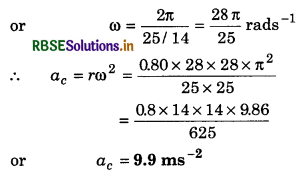
The direction of this acceleration is towards the centre of the circular path.
Question 4.18.
An aircraft executes a horizontal loop of radius 1.00 km with a steady speed of 900 km h-1. Compare its centripetal acceleration with the acceleration due to gravity.
Answer:
Given: r = 1.0 km = 1000 m; v = 900 km h-1
or v = 900 x \(\frac{5}{18}\) ms-1 = 250 ms-1
∴ Centripetal acceleration,
ac = \(\frac{v^2}{r}=\frac{250 \times 250}{1000}=\frac{25 \times 25}{10}=\frac{625}{10}\)
= 62.5 ms-2
∴ \(\frac{a_c}{g}=\frac{62.5}{9.8}\) = 6.38

Question 4.19.
Read each statement below carefully and state with reason it is true or false:
(a) The net acceleration of a particle in circular motion is always along the radius of the circle towards the centre.
(b) The velocity vector of a particle at a point is always along the tangent to the path of the particle at that point.
(c) The acceleration vector of a particle in uniform circular motion averaged over one cycle is a null vector.
Answer:
(a) False; because only in uniform circular motion, the acceleration is along the radius of the path
(b) True;
(c) True
Question 4.20.
The position of a particle is given by \(\vec{r}=\left(3.0 t \hat{i}-2 t^2 \hat{j}+4.0 \hat{k}\right)\) m, where t is in seconds and the coefficients have the proper units for \(\vec{r}\) to be in metres.
(a) Find the \(\vec{v}\) and \(\vec{a}\) of the particle.
(b) What is the magnitude and direction of velocity of the particle at t = 2.0 s?
Answer:
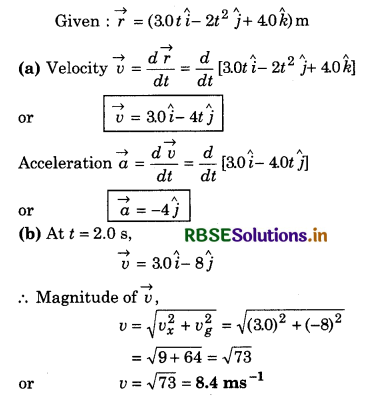
If velocity vector makes an angle θ with X-axis then
tan θ = \(\frac{v_y}{v_x}=\frac{8}{3}\)
∴ θ = tan-1\(\left(\frac{8}{3}\right)\)
Question 4.21.
A particle starts from the origin at t = 0 s, with a velocity of 10.0 \(\hat{j}\) ms-1 and moves in the X-Y plane with a constant acceleration of (8.0\(\hat{i}\) + 2.0\(\hat{j}\)) ms-2.
(a) At what time is the x-co-ordinate of the particle 16 m? What is the y-co-ordinate of the particle at that time?, (b) What is the speed of the particle at that time?
Answer:
Given: \(\vec{v}\) = 10 \(\hat{j}\) ms-1; \(\vec{a}\) = (8.0 \(\hat{i}\)+ 2.0 \(\hat{j}\)) ms-2
(a) Using relation S = ut + \(\frac{1}{2}\) at2, the position vector
\(\overrightarrow{r_{(t)}}=\overrightarrow{v_0} \times t+\frac{1}{2} \vec{a} t^2\)
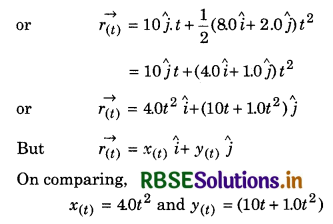
According to question, when x(t) = 16, then
4.0t2 = 16 ⇒ t2 = 4 ⇒ t = 2 s
At this time i.e., at t = 2 s,
y(t) = 10 x 2 + (2)2 = 20 + 4 = 24 m
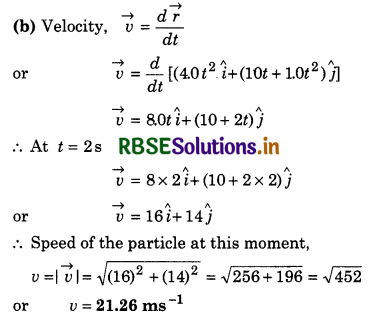
Question 4.22.
\(\hat{i}\) and \(\hat{j}\) are unit vectors along x and y-axis respectively. What is the magnitude and direction of the vectors (\(\hat{i}\) + \(\hat{j}\)) and (\(\hat{i}\) - \(\hat{j}\))? What are the components of vector \(\vec{A}\) = (2\(\hat{i}\) + 3\(\hat{j}\)) along the directions of (\(\hat{i}\) + \(\hat{j}\)) and (\(\hat{i}\) - \(\hat{j}\))? [You can use graphical method].
Answer:
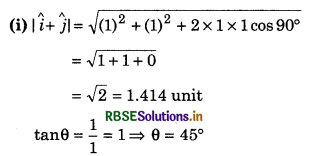
i.e., (\(\hat{i}\) + \(\hat{j}\)) makes an angle of 45° with X-axis
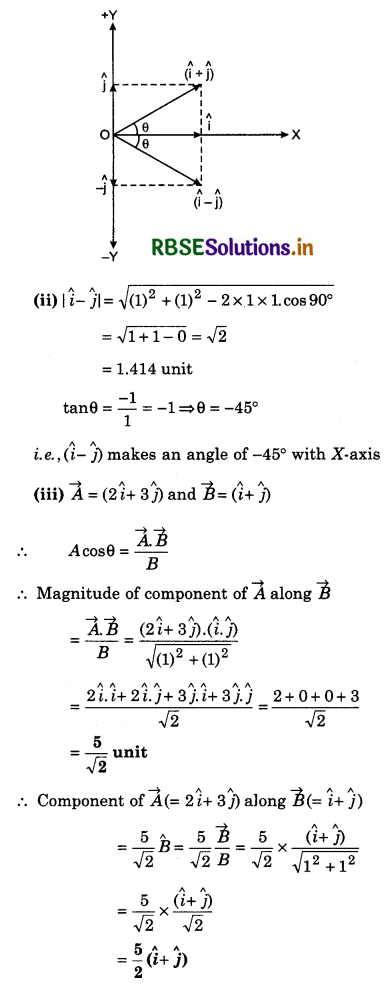
(iv) Similarly, if \(\vec{B}\) = (\(\hat{i}\) - \(\hat{j}\)), then magnitude of component of
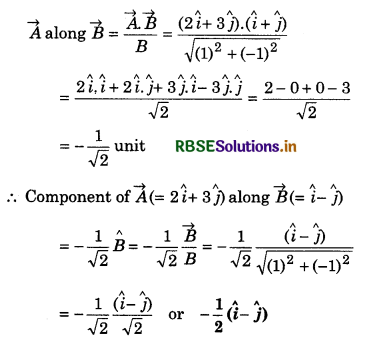
Question 4.23.
For any arbitrary motion in space, which of the following relations are true:
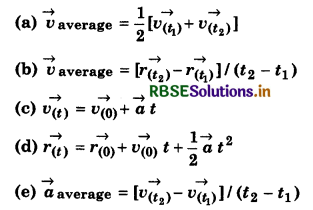
[The ‘average’ stands for average of the quantity over the time interval (t1 to t2)]
Answer:
For an arbitrary motion, the average velocity cannot be defined as in equation (a), so relation (a) is not true. As the motion is arbitrary, the acceleration may not be uniform, so the relations (c) and (d) cannot be true. Only relations (b) and (e) are true.
Question 4.24.
Read each statement below carefully and state with reasons and examples, if it is true or false. A scalar quantity is one that:
(a) is conserved in process.
(b) can never take negative values.
(c) must be dimensionless.
(d) does not vary from one point to another in space.
(e) has the same value for observers with different orientations of axes.
Answer:
(a) False; for example kinetic energy is a scalar quantity but it does not remain conserved in unelastic collisions.
(b) False; for example path length is a scalar quantity therefore it can be assumed positive or negative.
(c) False; relative density is a scalar quantity but it is not dimensionless
(d) False; electric potential is a scalar quantity and it changes from one point to other in space.
(e) True; mass m will remain unchanged on observing it with different orientations of axes.

Question 4.25.
An aircraft is flying at height of 3400 m above the ground. If the angle subtended at a ground observation point by the aircraft positions 10.0 s apart is 30°, what is the speed of the aircraft?
Answer:
From right angle ∆ OAC,
tan 15° = \(\frac{A C}{O C}\)
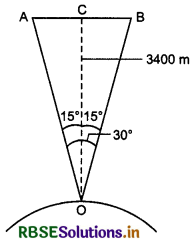
or AC = OC tan 15°
= 3400 m x 0.2679
= 911 m
∵ This distance AC has been covered in 5 s and if the speed of aircraft be v, then
AC = v x 5
⇒ v = \(\frac{A C}{5}=\frac{911}{5}\) = 182.2 ms-1
Additional Exercises
Question 4.26.
A vector has magnitude and direction. Does it have a location in space? Can it vary with time? Will two equal vectors o and at different locations in space necessarily have identical physical effects? Give examples in support of your answer.
Answer:
In addition to magnitude and direction, each vector also has a definite location is space. For example, velocity vector has definite location at every point of uniform circular motion. A vector may vary with time; for example increase in velocity produces acceleration.
Two equal vectors \(\vec{a}\) and \(\vec{b}\) having different locations may not produce identical physcial effects. For example: two forces (vectors) equal in magnitude and direction acting at two different points may not produce equal turning effects.
Question 4.27.
A vector has both magnitude and direction. Does it mean that anything that has magnitude and direction is necessarily a vector? The rotation of a body can be specified by the direction of the axis of rotation and the angle of rotation about the axis. Does that make any rotation in a vector?
Answer:
No; any physical quantity that has both magnitude and direction is not necessarily a vector unless it obeys the laws of vector addition. Usually rotation is not considered a vector even though it has magnitude and direction both as the addition of two finite rotations does not obey commutative law. However infinitesimally small rotations obey commutative law and hence an infinitesimally small rotation is considered as a vector.
Question 4.28.
Can you associate vector with (a) the length of a wire bent into a loop, (b) a plane area, (c) a sphere? Explain.
Answer:
Out of these cases, only a plane area can be associated with a vector. The direction of this area vector is taken normal to the plane.
Question 4.29.
A bullet fired at an angle of 30° with the horizontal hits the ground 3 km away. By adjusting the angle of projection, can one hope to hit a target 5 km away? Assume the muzzle speed to be fixed and neglect air resistance.
Answer:
In the first case,
R = 3km = 3000m; 6= 30°
Horizontal range, R = \(\frac{u^2 \sin 2 \theta}{g}\)
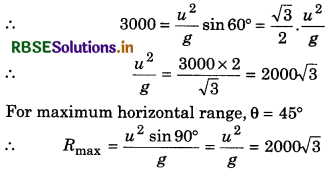
= 2000 x 1.732
= 3.464 x 1000m = 3.46 km
But distance of the target is 5 km which is greater than maximum horizontal range 3.46 km. Therefore the target cannot be hit by adjusting the angle of projection.
Question 4.30.
A fighter plane flying horizontally at the altitude of 1.5 km with a speed of 720 kmh-1 passes directly overhead an anti-aircraft gun. At what angle from the vertical should the gun be fired for the shell with muzzle speed 600 ms-1 to hit the plane? At what minimum altitude should the pilot fly the plane to avoid being hit? (Take g = 10ms-2)
Answer:
Speed of plane
u = 720 kmh-1
= 720 x \(\frac{5}{18}\)
= 200 ms-1
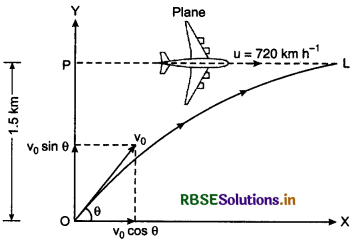
The shell moves along curve OL and the plane moves along PL. Let the shell hits the plane after time t.
Velocity of shell v0 = 600 ms-1
For hitting,
Horizontal distance travelled by plane = horizontal distance travelled by the shell.
∴ u x t = v0 cos θ x t
or 200 x t = 600 x cos θ x t
or 600 x cos θ = 200
∴ cos θ = \(\frac{200}{600}=\frac{1}{3}\)
∴ θ = cos-1(\(\frac{1}{3}\)) = 70°30' = 70.5°
The shell should be fired at an angle of 70°30' with horizontal.
Therefore angle of projection with vertical = 90° - 0 = 90° - 70.5° = 19.5°
Maximum height of flight of shell,
h = \(\frac{v_0^2 \sin ^2 \theta}{2 g}=\frac{v_0^2\left(1-\cos ^2 \theta\right)}{2 g}\)
= \(\frac{(600)^2\left(1-\frac{1}{9}\right)}{2 \times 10}\)
= 16000 m = 16 km
Thus the pilot should fly the plane at a miniumum altitude of 16 km to avoid being hit by the shell.
Question 4.31.
A cyclist is riding with a speed of 27 kmh-1. As he approaches a circular turn on road of radius 80 m; he applies brakes and reduces his speed at the constant rate of 0.50 ms-1 every second. What is the magnitude and direction of the net acceleration of the cyclist on the circular turn?
Answer:
Cyclist applies brakes to reduce his speed, as a result his motion is retarted as shown in figure.
Radial or centripetal acceleration \(\overrightarrow{a_c}\) acts towards the centre of the circular path.
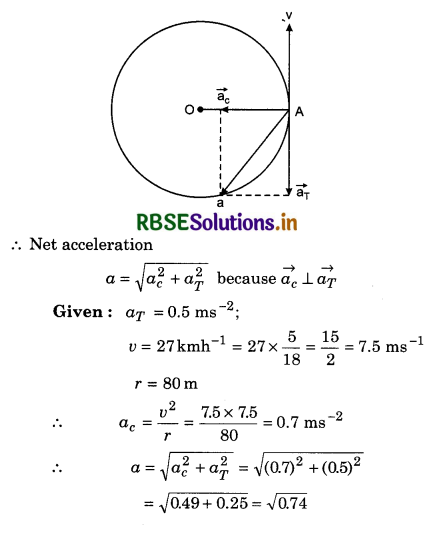
= 0.86 ms-2
If not acceleration makes an angle α with tangential acceleration, then
tan α = \(\frac{a_c}{a_T}=\frac{0.7}{0.5}=\frac{7}{5}\) = 1.4
∴ α = tan-1(1.4)
or α = 54.5°
∴ Angle of acceleration with velocity = π - α = 180° - 545°
= 125.5°
Question 4.32.
(a) Show that for a projectile, the angle between the velocity and the X-axis as a function of time is given by
θ(t) = tan-1[\(\frac{v_{0 y}-g t}{v_{0 x}}\)]
(b) Show that the projection angle θ0 for a projectile launched from the origin is given by.
θ0 = tan-1(\(\frac{4 h_m}{R}\))
Where the symbols have their usual meaning.
Answer:
(a) Suppose at t = 0, a projectile is projected at angle θ0 with horizontal, with initial velocity \(\vec{u}\).
Suppose the projectile is at point P at time t and its velocity is \(\vec{v}\) making an angle θ(t) with horizontal i.e., with X-axis.
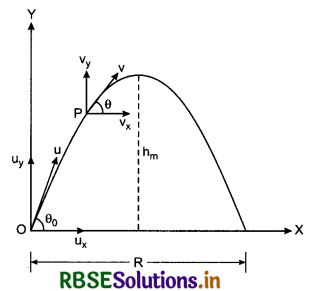
∵ The horizontal velocity remains unchanged if air resistance is negligible.
∴ ux = vx ......................(1)
Vertical velocity at time t,
vy = uy - gt .......................(2)
∴ tan θ(t) = \(\frac{v_y}{v_x}=\frac{u_y-g t}{u_x}\)
If u is represented by v0, then
or θ(t) = tan-1[\(\frac{v_{0 y}-g t}{v_{0 x}}\)] ........................(3)
(b) Range of the projectile,
R = \(\frac{u^2 \sin 2 \theta_0}{g}=\frac{u^2 2 \sin \theta_0 \cdot \cos \theta_0}{g}\) .........................(4)
Maximum height attained by projectile,
hm = \(\frac{u^2 \sin ^2 \theta_0}{2 g}\) ........................(5)
on dividing equation (5) by (4), we have
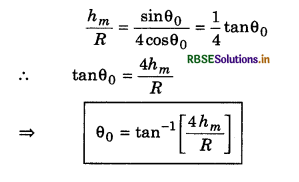

- RBSE Class 11 Physics Important Questions Chapter 4 Motion in a Plane
- RBSE Solutions for Class 11 Physics Chapter 15 Waves
- RBSE Solutions for Class 11 Physics Chapter 14 Oscillations
- RBSE Solutions for Class 11 Physics Chapter 13 Kinetic Theory
- RBSE Solutions for Class 11 Physics Chapter 12 Thermodynamics
- RBSE Solutions for Class 11 Physics Chapter 11 Thermal Properties of Matter
- RBSE Solutions for Class 11 Physics Chapter 10 Mechanical Properties of Fluids
- RBSE Solutions for Class 11 Physics Chapter 9 Mechanical Properties of Solids
- RBSE Solutions for Class 11 Physics Chapter 8 Gravitation
- RBSE Solutions for Class 11 Physics Chapter 7 System of Particles and Rotational Motion
- RBSE Solutions for Class 11 Physics Chapter 6 Work, Energy and Power